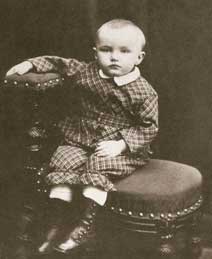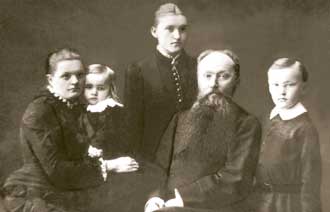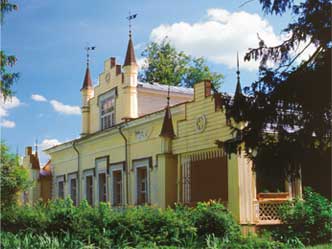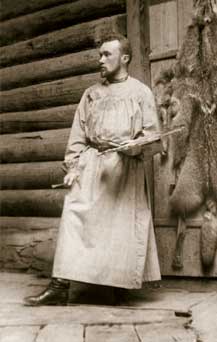| printer friendly | |||
|
|||
 | |
| Nicholas Roerich, 1877 |
A slender light frieze goes around the upper part of the Saint-Petersburg hall walls. Familiar architectural images of Saint-Petersburg arise before us: Kazansky Cathedral, Admiralty, Winter Palace, Academy of Arts, Copper Horseman, monument to Catherine the Great.
At the entrance, there are reduced copies of magnificent Egyptian sphinxes, decorating the embankment near the Academy of Arts in Saint-Petersburg.
Saint-Petersburg. Amazing city, city-museum, fairy-city, combining in itself various epochs and styles, which became the heart of Russia for many years. At the beginning of the XX century, this city gave to the world an incredible upsurge of art, science, and philosophy, which was called the Silver Age of the Russian culture. The city, in which the time formed high Spirit and high Culture.
And probably not by chance, it was in this city that, at the end of the XIX century, N. Roerich was born – a great artist, unique philosopher, outstanding scientist, famous traveler, and public figure of the world significance. Out of 73 years, 42 Nicholas Roerich lived in Saint-Petersburg, and he preserved for ever spiritual link with this amazing city, in which his multi-faceted talent revealed itself and sounded. Archeology. Painting. The East. These are the interests which, having appeared in Saint-Petersburg, led him along his life way.
 | |
| The Roerich family (from the left):
Maria Vassilievna (nee Kalashnikova), Vladimir, Lidia, Konstantin Fyodorovich, Nikolay. Saint-Petersburg, 1884 | |
 | |
| N. Roerich’s Museum-Estate in Izvara |
Documents and photographs exhibited in the hall show that Nicholas Roerich was born in the family of Saint-Petersburg Notary Konstantin Roerich. His father belonged to an ancient Scandinavian family of the Roerichs, representatives of which, having settled in Russia at the time of Peter I, were famous for their bravery and courage. Nicholas Roerich’s mother, Maria – came from a Russian Pskov family of the merchants Kalashnikovs.
The parents brought up their children on lofty ideals of the good, honor, diligence, they tried to arouse their interest for natural sciences, history, literature, music. The Roerichs’ family photograph (1884) in one of the hall show-cases captured Nicholas with his parents, his sister Lydia, and brother Vladimir.
In the same show-case, the photograph of Roerich as a gymnasium student (1886) is exhibited. He studied in the K. May Gymnasium – one of the best schools of Saint-Petersburg, then in the Saint-Petersburg Academy of Arts, and at the University, at the Faculty of Law. It seemed Nicholas Roerich’s life was not at all different from other people’s. A usual life of a young man, first gymnasium student, then University student. With all its joys, difficulties, disappointments, and hopes. But already in the early childhood, he, still a boy, was irresistibly attracted by all that afterwards became the cause of his life.
On one of the photographs, we see an ancient sound house with a facade decorated with little Gothic towers. This is the house in Izvara – the Roerichs’ estate near Saint-Petersburg. Ancient mounds rose in the fields and forests surrounding the estate. At the age of 9, Roerich-Junior performed his first excavations. Coming to contact with relics of distant centuries was inexpressible and unexpected. It seemed to the boy that the current of the ancient times penetrated through his fingers and aroused some vague pictures standing out from the haze of the past, carrying in themselves unknown distant life.
This ability to get imbued with Time and realize its essence was a happy and difficult gift. Much later he would write about it himself: “It is a wringing and pleasant feeling, to be the first to extract from the earth some antiquity, to come to immediate communication with a long passed epoch. The grey many-century haze is fluctuating, with each stroke of the spade, with each strike of the crowbar, fascinating fairy kingdom is revealed before you; wider and richer, wonderful pictures are unfolded”[1, p.21]. “How much mystery! How much miracle! And in death itself – the endless life is contained”[2, p.29].
 | |
| Nicholas Roerich. Izvara. 1900s |
Archeology would pass through Nicholas Roerich’s whole life. Excavations in the North of Russia, in Novgorod, in Tibet, and in the Indian Himalayas. He would become a professional archeologist. His archeological studies would be analyzed by scientists, who would make reports on them at scientific conferences, and everything would start from the ancient mounds of Izvara.
“All the special, all the dear and memorial is connected with the summer months in Izvara. The name is derived from the Hindu word “Isvara”. At the time of Catherine, there lived some Hindu raja nearby. <…> Something else from the earliest memories: an ancient painting – a mountain at the sunset. Later it turned out to be nothing else but Kanchenjunga. From where? How did it get there?”[3, p.97-98] After many years, the artist would see Kanchenjunga without the frame, in all the richness of amazing colors. He would paint it on his canvases, would live at its foot, and see it from the window of his house. This house would be in distant India. But for the time being, India was just entering his life – the Time was putting its landmarks and weaving its complicated pattern.
“My very first mound findings did not only coincide with my favorite history lessons, but, in my recollections, are also close to geography, and Gogol’s historical fantasy”[4, p.149], N. Roerich remembered. Experienced geographer K. May suggested that the names be not only learned, but that “the hieroglyphs of the earth be fixed with lines, and colors, and relieves. In doing that, love, and attention, and commensurability of earthly outlines were awakened”[5, p.148]. Mountains and deserts of the Asian continent irresistibly attracted young Roerich. He listened attentively to the stories of Orientalists who used to come to his father’s house, he read the books of Przhevalsky, Kozlov, Potanin. “Each memory from Asia was something especially warm, from the early years and for the whole life”[6, p.114], Nicholas Roerich wrote. Love for archeology, interest for the past, attraction to the East sounded in the young man’s soul and demanded their expression.
|
|
||
|
||
